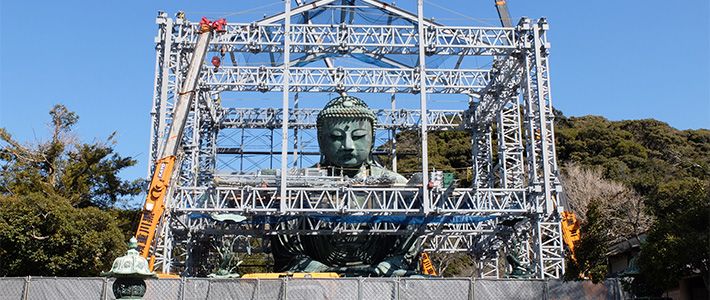
A Clean Bill of Health for Kamakura’s Great Buddha
Guideto Japan
Society Culture- English
- 日本語
- 简体字
- 繁體字
- Français
- Español
- العربية
- Русский
“We really didn’t know what to expect,” explains Morii Masayuki (39), a senior researcher at the National Research Institute for Cultural Properties, Tokyo, who headed the diagnostics, repair, and cleaning project. “The Buddha is some 760 years old and has been sitting outside for more than 500 years, exposed to salty sea breezes, continual seismic shaking, bird droppings, and—in recent decades—to acid rain and vibration from nearby vehicle traffic.
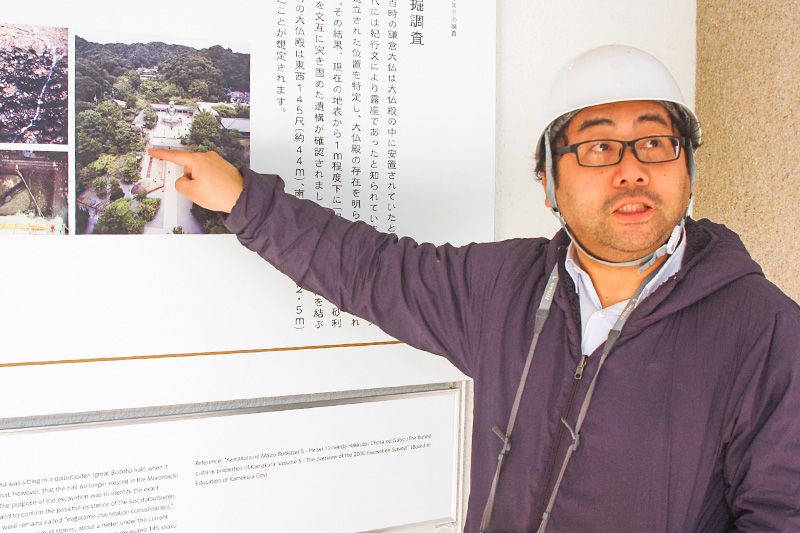 Morii Masayuki overseeing the Kamakura Daibutsu project. Following the March 11 disaster, he also commuted to Fukushima Prefecture to supervise post-earthquake restoration work at a site famed for its stone Buddhas.
Morii Masayuki overseeing the Kamakura Daibutsu project. Following the March 11 disaster, he also commuted to Fukushima Prefecture to supervise post-earthquake restoration work at a site famed for its stone Buddhas.
“So we knew who the main villains were. But we didn’t know how much mischief they had caused. We were therefore happy to discover that the Buddha was structurally sound and that the corrosion was largely benign.”
Kamakura’s Great Buddha evokes, to be precise, the Amitābha Buddha (Amida Butsu), revered especially by adherents of the Pure Land Buddhist sects. Those teachings hold that rebirth in paradise—the “pure land”—awaits believers who take refuge in Amitābha. They admonish the believers to attain salvation by reciting the Buddha’s name repeatedly. In Japanese, that becomes the chant “Namu Amida Butsu, Namu Amida Butsu . . .” (Ah, Amitābha Buddha . . .).
We need to understand the famously beatific visage of Kamakura’s Daibutsu in the context of Amitābha’s embrace of the faithful. The visage’s March 11 re-emergence is a moving commemoration of the more than 16,000 lives lost in the 2011 quake and tsunami. Its auspicious timing, however, was apparently serendipitous. The Daibutsu stands—or, rather, sits—on the grounds of the temple Kōtoku-in. And Kōtoku-in’s chief priest, Satō Takao (52), insists that the timing was “simply how things worked out in the work scheduling.”
A Paucity of Historical Evidence
Our knowledge of the history of Kamakura’s Daibutsu relies on historical documentation that is remarkably sparse. The Azuma kagami (Mirror of the East), a thirteenth-century account of the Kamakura period (1185–1333), reports that work on the Daibutsu began in 1252. But we lack any historical documentation of the date of the completion of the statue or, for that matter, of the identity of the sculptor.
Morii’s observation that the Daibutsu has resided outdoors for “more than 500 years” jibes with historical accounts while indirectly acknowledging their paucity. We know that Kamakura’s Daibutsu originally resided indoors, like the even larger Daibutsu at the temple Tōdaiji in Nara. But we lack any historical documentation about when it lost its protective shelter for good.
The late-fourteenth-century historical epic Taiheiki reports that the Kamakura Daibutsu’s shelter collapsed in a typhoon in 1334. And the sixteenth-century chronicle Kamakura dainikki mentions the destruction of the housing by a typhoon in 1369 and by an earthquake and tsunami in the late 1490s. The latter mention, though, is questionable. A 1486 entry in a poetry collection by the Zen monk Banri Shūkyū, Baika mujinzō, describes the Daibutsu as sitting outdoors and unsheltered.
A Beloved Presence
“This [diagnostics, repair, and cleaning] project was a powerful reminder,” marvels Morii, “of just how much the Daibutsu means to the Japanese. The media devoted extensive coverage to the project. And visitors kept streaming into Kōtoku-in to have a look, even though they knew that the Daibutsu was under wraps.”
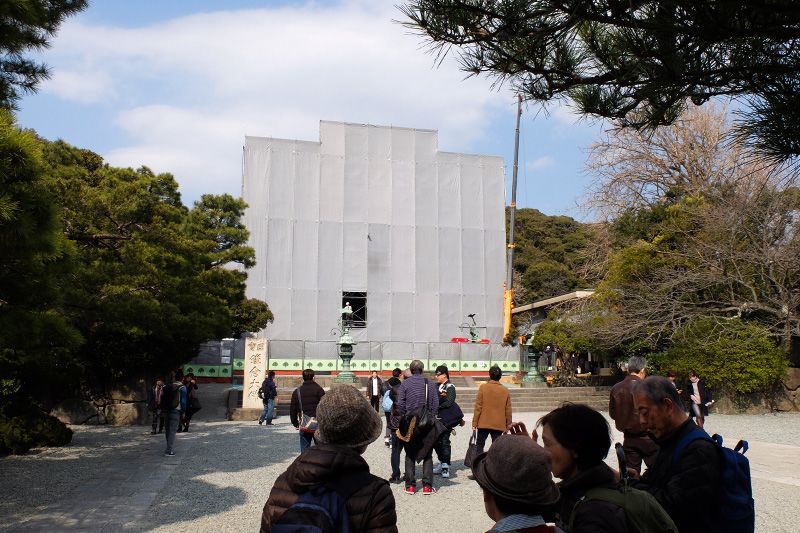 The Daibutsu’s diagnostic and repair work took place from January 13 to the end of February, 2016. The Daibutsu then received a thorough cleaning, and the last of the scaffolding came down on March 10.
The Daibutsu’s diagnostic and repair work took place from January 13 to the end of February, 2016. The Daibutsu then received a thorough cleaning, and the last of the scaffolding came down on March 10.
That at least most visitors knew that the Daibutsu was “under wraps” is a tribute to conscientious efforts by Kōtoku-in and the community. The temple’s well-maintained website carried a prominent notice about the project, and Kōtoku-in waived the customary ¥200 entrance fee while the Daibutsu was out of view. Asking directions at any shop en route invariably elicited the caution, “But you won’t be able to see the Daibutsu.” Yet still they came.
 Satō Takao, the chief priest of Kōtoku-in. Apart from his work at the temple, Satō serves as a professor at Keiō University, where his teaching and research center on ethnology and archaeology.
Satō Takao, the chief priest of Kōtoku-in. Apart from his work at the temple, Satō serves as a professor at Keiō University, where his teaching and research center on ethnology and archaeology.
“People seem to feel the presence of the Daibutsu,” observes Satō, “even when they can’t see it with their eyes.” Morii agrees. “They just want to get close,” he notes. “It’s more than a matter seeing something.” Satō adds that the sense of touch is also important in experiencing the Daibutsu.
“Our open-door policy in allowing visitors inside the Daibutsu comes up in connection with our national treasure designation,” says Satō. “The government administrators of the national treasure program take a dim view of that access. They point to the graffiti and the chewing gum that thoughtless visitors leave on the walls. And they argue that we should stop letting people inside.
“I insist, however, on keeping the door open. Access to the interior is especially important for sight-impaired visitors. Placing hands on the bronze and feeling the winter cold or the summer heat makes for incredibly intimate interaction with the Daibutsu. I’d never sacrifice that just to spare us the chore of removing chewing gum and graffiti.”
A History of Graffiti
To be sure, chewing gum and graffiti are an appalling indictment of disgraceful behavior, albeit by a minuscule minority of visitors. “We found and removed more than a dozen pieces of chewing gum,” sighs Morii. “We also removed some graffiti. The stuff written with felt pens is pretty easy to remove with alcohol. Curiously, the stuff in chalk and in sumi ink is all but impossible to remove. Of course, we could sandblast it off, but that would damage the bronze. And that would run counter to our policy of preserving the Daibutsu as it is.”
Graffiti, sad to say, has a long history at Kōtoku-in. Witness the following account by the English sea captain John Saris, who commanded the first English ship to reach Japan. Saris’s ship, the Clove, docked in Hirado in June 1613, and Saris subsequently traveled to Edo, where he met with the retired shōgun, Tokugawa Ieyasu, and the current shōgun, Tokugawa Hidetada. Escorting Saris was the Englishman William Adams, celebrated in the book and television miniseries Shogun. Adams had arrived 13 years earlier, but he had traveled as the navigator on a Dutch ship.
The Countrey betwixt Surnunga and Edoo is well inhabited. We saw many Fotoquise (hotokes, Buddhas) or Temples as we passed, and amongst others an Image of especiall note, called Dabis (Daibutsu), made of Copper, being hollow within, but of a very substantiall thickness. It was in height, as we ghessed, from the ground about one and twentie or two and twentie foot, in the likenesse of a man kneeling upon the ground, with his buttockes resting on his heeles, his arms of wondefull largenesse, and the whole body proportionable. He is fashioned wearing of a Gowne. This Image is much reverenced by Travellers as they passe there. Some of our people went into the bodie of it, and hoope and hallowed, which made an exceeding great noyse. We found many Characters and Markes made uon it by Passengers, whom some of my Followers imitated, and made theirs, in like manner.The Voyage of Captain John Saris to Japan, 1613 Edited by Sir Ernest M. Satow
The sumi-ink graffiti, applied with brushes, is something of a mystery. Visitors in any era would not ordinarily have been carrying ink and brushes. Morii suspects that Kōtoku-in provided the materials to visitors in the late nineteenth and early twentieth centuries and encouraged them to sign their names inside the Buddha in exchange for a donation.
Satō denies that anyone at the temple would have encouraged graffiti under any guise. But he acknowledges that his predecessors had a difficult time making ends meet and that they relied heavily in income from visitors. “Kamakura was a popular daytrip destination,” reflects Satō, “for residents in Yokohama’s foreign enclave. The foreigners couldn’t travel into Tokyo without permission, but they were free to move about at will between Yokohama and Kamakura. And the Daibutsu was, of course, a favorite stop.”
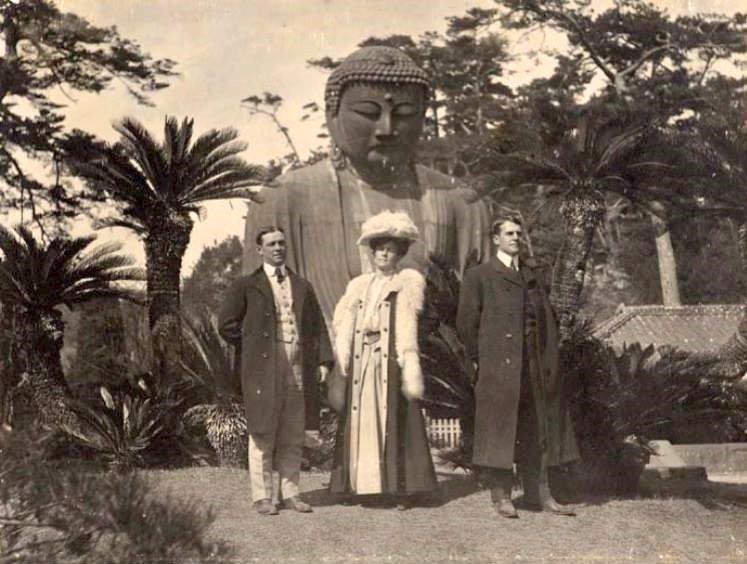 Daytrips to Kamakura were a favored pastime for residents of Yokohama’s foreign enclave in the late nineteenth century. © Kōtoku-in
Daytrips to Kamakura were a favored pastime for residents of Yokohama’s foreign enclave in the late nineteenth century. © Kōtoku-in
Today, Kōtoku-in and the Daibutsu attract some 2 million visitors a year, and non-Japanese account for about 200,000 of the total. “The Daibutsu is especially popular,” reports Satō, “with visitors from the Theravada Buddhist nations of Thailand and Myanmar.”
Joseph Rudyard Kipling also drew a connection between Myanmar and the Kamakura Daibutsu in his poem “Buddha at Kamakura.” A verse in that work, which Kipling included in the collection The Five Nations, refers to Yangon’s glorious Shwedagon Pagoda (“Shwe-Dagon”) and to its htee gilded top piece.
Till drowsy eyelids seem to see
A-flower ’neath her golden htee
The Shwe-Dagon flare easterly
From Burmah to Kamakura
The Statue as Living Being
The impressive durability of Kamakura’s Daibutsu means that we encounter the same commanding presence that towered before Kipling. The bronze statue stands more than 11 meters tall atop a 2-meter-high stone platform. Its eyes are each a meter wide, and the coiffure sports 656 coils. The bronze weighs in at 121 tons. (This page on the Kōtoku-in website includes an animated description of the casting process employed to make the Kamakura Daibutsu.)
Nara’s Daibutsu, which evokes the Vairocana Buddha (Japanese: Birushana Butsu, also Dainichi Nyorai), is, as noted, larger than its Kamakura counterpart. It has undergone repeated reconstruction, however, over the centuries, whereas the Kamakura Daibutsu is structurally unchanged from the day it was completed.
The single significant change in the Kamakura Daibutsu has been the loss of its gold covering. Traces of gold on the Daibutsu’s right cheek hint at the original appearance. But mysteries abound.
“Metallurgists have suggested,” acknowledges Morii, “that the high lead content in the bronze made plating impossible and obliged the builders to use gold foil. But I’ve taken a close look at the gold traces, and I’m not so sure.”
Restoring the gilt was never a serious consideration. “We are caring for the Daibutsu as a living being,” emphasizes Morii. “This Buddha, as you see it today, has been part of Japanese society for centuries. We have no business tackling some sort of makeover in the name of restoring a supposed ‘original appearance.’”
In any case, the issue of regilding the Daibutsu is moot, according to Satō. “Making fundamental changes in something designated a national treasure is all but impossible.”
“Another mystery,” muses Morii, “is where in the world, literally, they came up with all that bronze. Japan’s output of copper at the time would have been woefully insufficient. So our eyes turn to China. Some metallurgists have noted a similarity between the content of the Daibutsu’s alloy and bronze known to have been imported from Song dynasty China. But here again, the historical record is incomplete, leaving us to speculate.”
Previous repairs on the Daibutsu included rebuilding the stone platform in 1925. That followed the destruction of the platform in Great Kanto Earthquake of 1923, when the Daibutsu rocked and slid 35 centimeters forward. Subsequent repairs included strengthening the neck from inside with fiber-reinforced plastic in the early 1960s. The 1960s work also included inserting a stainless steel plate between the bronze statue and the stone platform. That was to protect the Daibutsu from earthquakes by allowing it to slide, rather than topple.
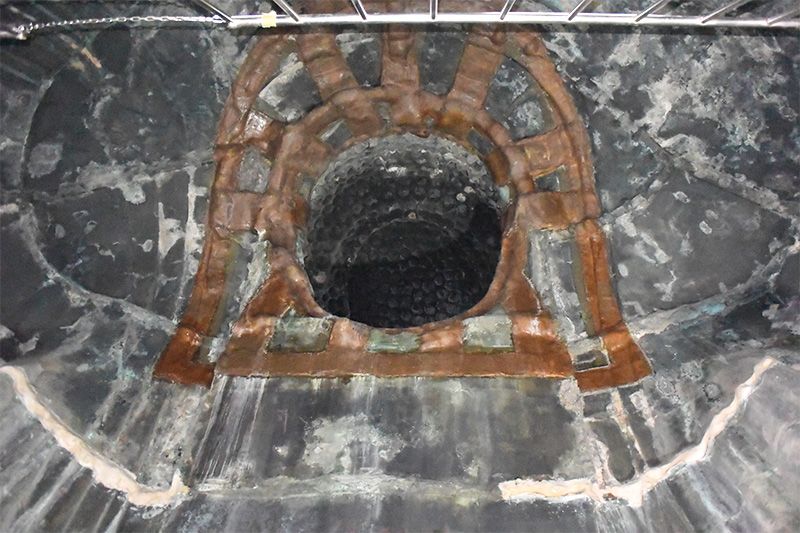 The examination and repair work conducted in 1960–61 included strengthening the Daibutsu’s neck from inside with fiber-reinforced plastic. © the National Research Institute for Cultural Properties, Tokyo
The examination and repair work conducted in 1960–61 included strengthening the Daibutsu’s neck from inside with fiber-reinforced plastic. © the National Research Institute for Cultural Properties, Tokyo
“We took a look at the stainless steel,” says Morii, “and it appears to be in pretty good shape. The seismic force in Kamakura during the Great East Japan Earthquake of 2011 was insufficient to trigger any sliding. Whether the seismic protection will really work as designed is an open question. That’s something that we’ll need to study in the years ahead.”
As Satō and Morii continue caring for their 760-year-young Buddha, they can take heart in the approval that resounds in Kipling’s verse.
A tourist-show, a legend told,
A rusting bulk of bronze and gold,
So much, and scarce so much, ye hold
The meaning of Kamakura?But when the morning prayer is prayed,
Think, ere ye pass to strife and trade,
Is God in human image made
No nearer than Kamakura?
(Banner photo: Kamakura’s Daibutsu shows its face anew to the world in early March 2016 as the wraps come off after nearly two months of testing, fixing, and cleaning. Photo by Doi Emi, Nippon.com)